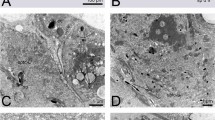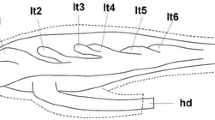Abstract
The spermathecal complex ofPhlebotomus papatasi Scopoli (Diptera: Psychodidae) undergoes histological and physiological changes during its gonotropic cycle. The present histochemical study revealed a mucopolysaccharide secretory mass in the spermathecae of the newly emerged sandfly. Sperm competition occurs when two or more males compete to fertilize an ovum in the female reproductive tract. In this study, spermatophores of two or more competing males were deposited at the base of the spermathecal ducts, which originate from the female bursa copulatrix. This suggests that females play a role in sperm displacement, which is defined as any situation in which the last male to mate with a female fertilizes maximum number her eggs. A blood meal ingested by the female for ovary development and egg laying stimulates the release of sperm from the spermatophore. The spermatozoa then migrate to the lumen of the spermatheca. The ultrastructure of spermatozoa comprises a head with double-layered acrosomal perforatorium, an elongate nucleus, and the axoneme with a 9 + 9 + 0 flagellar pattern. This axomene differs from the aflagellate axoneme of other Psychodinae. Morphological changes, such as the casting off of the acrosomal membrane, and histological changes in the spermatophore are also described. Mating plugs that have been described previously in sandflies appear to be artefacts. Females ofP. papatasi may be inseminated more than once during each gonotrophic cycle, and additional inseminations may be necessary for each cycle. The relationships between the volumes of the sperm and the spermatheca were calculated to determine sperm utilization and fecundity ofP. papatasi. As the females ofP. papatasi mate polyandrously, the anatomical and physiological complexity of the spermathecal complex may be related to post-copulatory sexual selection.
Similar content being viewed by others
References
Alonso-Pimental H, Tolbert L P and Heed W B 1994 Ultrastructural examination of insemination reaction inDrosophila;Cell Tissue Res. 275 467–479
Arnqvist G M, Edvardsson U and Friberg Nilsson T 2000 Sexual conflict promotes speciation in insects;Proc. Natl. Acad. Sci. USA 97 10460–10464
Bancroft J D and Stevens A 1990Theory and practice of histological techniques (London: Churchill Livingstone)
Bickel D 1990 Sex with a twist in the tail;New Sci. 8 34–37
Chen P S 1996 The accessory gland proteins in maleDrosophila melanogaster: structural, reproductive and evolutionary aspects;Experientia 52 503–510
Dallai R, Baccetti M and Mazzini D 1984 The spermatozoon of three species ofPhlebotomus (Phlebotominae) and acrosomal evolution in Nematoceran dipterans;Int. J. Insect Morphol. Embryo. 13 1–10
Davey K G 1985 The female reproductive tract; inComprehensive insect physiology, biochemistry and pharmacology (eds) G A Kerkut and L I Gilbert (Oxford, UK: Pergamon Press) vol. 1, pp 15–36
Degrugillier M E and Leopold R 1976 Ultrastructure of sperm penetration of house fly eggs;J. Ultrastruct. Res. 56 312–325
Eberhard W G 1996Female control: sexual selection by cryptic female choice (Princeton: Priceton University Press)
Eberhard W G 1998 Females role in sperm competition; inSperm compettion and sexual selection (eds) T R Birkhead and A P Moller (London: Academic Press) pp 91–116
Eberhard W G and Huber B A 1998 Copulation and sperm transfer inArchsepsis flies (Diptera: Sepsidae) and the evolution of their intromittant genitalia;Studia Diptera 5 217–248
Elia A J, Tebrugge V A and Orchard I 1993 The pulsatile appearance of FMRF amide-related peptides in the haemolymph and loss of FMRF amide-like immunoreactivity from neurohaemal areas ofRhodnius prolixus following a blood meal;J. Insect Physiol. 39 459–469
Giglioli M E C and Mason G F 1966 The mating plug in anopheline mosquitoes;Proc. R. Entomol. Soc. London 41 123–129
Gillott C 2003 Male accessory gland secretions: Modulations of female reproductive physiology and behaviour;Annu. Rev. Entomol. 48 163–184
Gomendio M and Roldan E R S 1991 Sperm size and sperm competition in mammals;Proc. R. Soc. London B243 181–185
Grodner M L and Steffans W 1978 Evidence of a chemotactic substance in the spermathecal gland of the female boll weevil;Trans. Am. Microsc. Soc. 97 116–120
Happ G M and Happ C M 1970 Fine structure and histochemistry of the spermathecal gland in the meal worm beetleTenebrio molitor;Tissue Cell 2 443–446
Hellriegel B and Bernasconi G 2000 Female-mediated differential sperm storage in a fly with complex spermthecae,Scatophaga stercoraria;Anim. Behav. 59 311–317
Holland B and Rice W R 1998 Chase-away sexual selection: antagnostic seduction verses resistance;Evolution 52 1–7
Hosken D J and Ward P I 2000 Copula in yellow dung flies (Scatophaga stercoraria): investigating sperm competition models by direct investigation;J. Insect Physiol. 46 1355–1363
Hosken D J and Stockley S 2004 Sexual selection and genital evolution;Trends Ecol. Evol. 19 87–93
Ilango K and Lane R P 2000 Coadaptation male aedeagal filaments and female spermathecal ducts of the Old World Phlebotomine sand flies (Diptera: Psychodiddae);J. Med. Entomol. 37 563–569
Ilango K 2005 Structure and function of the spermathecal complex in the Phlebotomine sandflyPhlebotomus papatasi Scopoli (Diptera: Psychodidae): I Ultrastructure and histology;J. Biosic. 30 711–731
Kaulenas M S 1992Insect accessory reproductive structures: function, structures, and development (Berlin, Heidelberg: Springer-Verlag)
Killick-Kendrick R 1990 Phlebotomine vectors of leishmaniases: a review;Med. Vet. Entomol. 4 1–24
Kortaba M 1996 Sperm transfer by spermtophore in Diptera: New results from the Diopsidae;Zool. J. Linn. Soc. 38 349–367
Leppla N C, Carlysle T C and Guy R H 1975 Reproductive systems and the mechanics of copulation inPlecia nearctica Hardy (Diptera: Bibionidae);Int. J. Insect Morphol. Embryol. 4 299–305
Leopold R A and Degrugiller M E 1973 Sperm penetration of house fly eggs: Evidence for involvement of a female accessory secretion;Science 181 555–557
Linley J R 1981a Emptying and spermathecal filling inCulicoides melleus (Diptera: Ceratopogonidae);Can. J. Zool. 59 347–356
Linley J R 1981b Ejaculation and spermatophore formation inCulicoides melleus (Diptera: Ceratopogonidae);Can. J. Zool. 59 377–386
Linley J R and Simmons K R 1981 Sperm motility and spermthecal filling in lower Diptera;Int. J. Invert. Reprod. 4 137–146
Lloyd J E 1979 Mating behavior and natural selection;Florida Entomol. 621 7–34
MacGregorM J 1931 The nutrition of adult mosquitoes: Preliminary contribution;Trans. R. Soc. Trop. Med. Hyg. 4 465–472
Mann T 1984Spermatophores: Development, structures, biochemical attributes and role in the transfer of spermatozoa (Berlin, Heidelberg: Springer-Verlag)
Maroli M, Bettini S, Tricoli D, Khoury C and Perrotti E 1991 Studies on the mating plug of two sandfly speciesPhlebotomus perniciosus andP. papatasi (Diptera: Psychodidae);Parassitologia 33 405–411
Nielsen E T 1959 Copulation ofGlyptotendipes paripes;Nature (London) 184 1252–1253
Parker G A 1970 Sperm competition and its evolutionary consequences in the insects;Biol. Rev. 45 525–567
Pitnick S, Markow T and Spicer G S 1999 Evolution of multiple kinds of female sper-storage organs inDrosophila;Evolution 53 1804–1822
Pitnick S and Brown W D 2000 Criteria for demonstrating female sperm choice;Evolution 54 1052–1056
Pitnick S, Miller G T, Schneider K and Markow T A 2003 Ejaculates-female coevolution inDrosophila mojavensis;Proc. R. Soc. London B 270 1507–1512
Polak M, Wolf C L, Starmer W T and Basker J S 2001 Function of mating plug inDrosophila hibisci;Behav. Ecol. Soc. 49 196–205
Pollock J N 1970 Sperm transfer by spermatophores inGlossina austeni;Nature (London) 225 1063–1064
Presgraves D C, Bakes R H and Wilkinson G S 1999 Coevolution of sperm and female reproductive tract morphology in stalk-eyed flies;Proc. R. Soc. London B 266 1041–1047
Ridely M1989 The incidedence of sperm displacement in insects: four conjectures, one corroboration;Biol. J. Linn. Soc. 38 349–367
Rudin W and Hecks H 1982 Functional morphology of the midgut of a sandfly as compared to other haematophagus Nematocera;Tissue Cell 14 751–758
Roldan E R S, Gomendio M and Vitullo A D 1992 The evolution of eutherian spermatozoa and underlying selective forces: Female selection and sperm competition;Biol. Rev. 68 551–593
Roy D N 1940 Influence of spermathecal stimulation of the physiological activities ofAnopheles subpictus;Nature (London) 3680 747–748
Selmi M G 1992 Sperm storage and decapaciation; inInternational Symposium on Origin and Evolution of Sex (ed.) Dallai (Siena: Italy) pp 1–20
Simmons L W and Siva-Jothy M T 1998 Sperm competition in insects: mechanisms and the potenial for selection; inSperm competition and sexual selection (eds) T R Birkhead and A P Moller (London: Acadademic Press) pp 341–434
Villavaso E J 1975 The role of the spermathecal gland of the boll weevilAnthonomus grandis;J. Insect Physiol. 21 1457–1462
Walker W F 1980 Sperm utilization strategies in nonsocial insects;Am. Nat. 115 780–799
Ward P I 2000 Cryptic female choice in the yellow dung flyScathophaga stercoraria;Evolution 54 1680–1686
Wenk P 1965 Uber die Biologie blutsaugender Simuliiden (Diptera). II. Schwarmverhalten, Gechlechterfindung und Kopulation;Z. Morphol. Okol. Tiere 55 671–713
Yuval B and Schlein Y 1986 Evidence for polygamy inPhlebotomus papatasi;Ann. Parasitol. Hum. Comp. 61 693–694
Author information
Authors and Affiliations
Corresponding author
Rights and permissions
About this article
Cite this article
Ilango, K. Structure and function of the spermathecal complex in the phlebotomine sandflyPhlebotomus papatasi Scopoli (Diptera: Psychodidae): II. Post-copulatory histophysiological changes during the gonotrophic cycle. J. Biosci. 30, 733–747 (2005). https://doi.org/10.1007/BF02703572
Received:
Accepted:
Published:
Issue Date:
DOI: https://doi.org/10.1007/BF02703572




